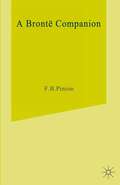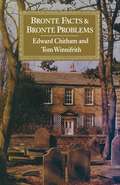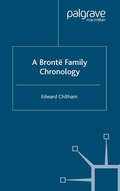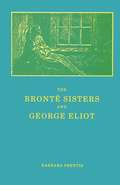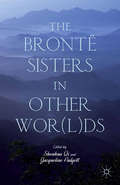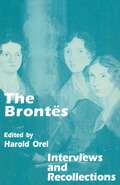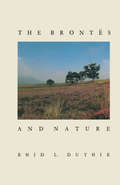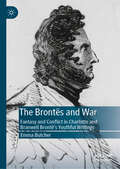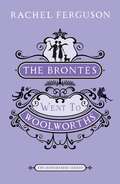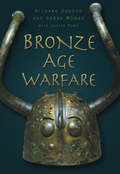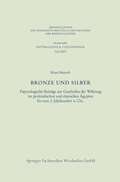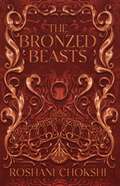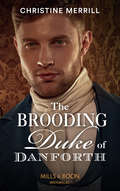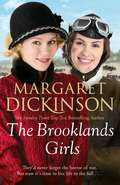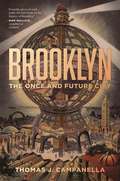- Table View
- List View
Brokers of Public Trust: Notaries in Early Modern Rome
by Laurie NussdorferA fast-growing legal system and economy in medieval and early modern Rome saw a rapid increase in the need for written documents. Brokers of Public Trust examines the emergence of the modern notarial profession—free market scribes responsible for producing original legal documents and their copies.Notarial acts often go unnoticed, but they are essential to understanding the history of writing practices and attitudes toward official documentation. Based on new archival research, Brokers of Public Trust focuses on the government officials, notaries, and consumers who regulated, wrote, and purchased notarial documents in Rome between the 14th and 18th centuries. Historian Laurie Nussdorfer chronicles the training of professional notaries and the construction of public archives, explaining why notarial documents exist, who made them, and how they came to be regarded as authoritative evidence. In doing so, Nussdorfer describes a profession of crucial importance to the people and government of the time, as well as to scholars who turn to notarial documents as invaluable and irreplaceable historical sources. This magisterial new work brings fresh insight into the essential functions of early modern Roman society and the development of the modern state.
A Bronte Companion: Literary Assessment, Background and Reference (Literary Companions)
by F. B. PinionBronte Country: Lives & Landscapes
by Peggy HewittHaworth and its moors are for ever linked with the name of Bronte, but they also have a fascination in their own right. Peggy Hewitt tells the story of the moors and of the people who have lived and worked there-people who are as much a product of their environment as the drystone walls and heather.
A Bronte Family Chronology (Author Chronologies Series)
by E. ChithamThis new addition to Palgrave Macmillan's Author Chronologies Series details events in the lives of the Brontë sisters and their associates. Major events such as the publication of history of their works are included, and are balanced by details of Brontë domestic life. There are original discussions, in the light of chronology, of the scandal affecting the Brontë's brother, Branwell, and the imaginary kingdoms shared by all four children.
The Bronte Sisters and George Eliot: A Unity of Difference
by Barbara PrentisAn approach to the lives, thought and works of the Bronte sisters and George Eliot. Seen against the background of the dramatically changing world, their attitudes to such vital issues as religion, the child, the "woman question", love and sexuality, the self and death are examined.
The Brontë Sisters in Other Wor(l)ds
by Shouhua Qi Jacqueline PadgettLooking at the works of the Brontë sisters through a translingual, transnational, and transcultural lens, this collection is the first book-length study of the Brontës as received and reimagined in languages and cultures outside of Europe and the United States.
The Brontes: A Family History
by John CannonWhat was the nature of the Brontes' strange genius? Where did it spring from and what inspired it? Patrick Bronte, father of the Bronte sisters, came from Ireland, changing his name from Brunty to Bronte when he won a scholarship to Cambridge. His children never met their Irish relatives. This work deals with this subject.
The Brontes: Interviews and Recollections (Interviews and Recollections)
by Harold OrelThe Brontes, living in an isolated village in Yorkshire, wrote some of the most vivid, imaginative, and widely-read novels of the Victorian Age; they also became the subject-matter of romanticized anecdotes and regrettably distorted biographies. The best testimony about what kinds of men and women they really were comes from statements they made themselves; but because their autobiographical commentaries are sparse, the record is usefully supplemented in this anthology by first-hand statements made not only by various inhabitants of Haworth, but by those who met members of the Bronte family in Yorkshire, London, and elsewhere.
The Brontës and War: Fantasy and Conflict in Charlotte and Branwell Brontë’s Youthful Writings
by Emma ButcherThis book explores the representations of militarisim and masculinity in Charlotte and Branwell Brontë’s youthful writings. It offers insight into how the siblings understood and reimagined conflict (both local and overseas) and its emotional legacies whilst growing up in early-nineteenth-century Britain. Their writings shed new light on a period little discussed by social and military historians, providing not only a new approach to Brontë Studies, but also acting as a familial case study for how the media captivated and enticed the public imagination.
The Brontes Went to Woolworths: A Novel (Virago Modern Classics #Vol. 279)
by Rachel Ferguson'How I loathe that kind of novel which is about a lot of sisters'; so proclaims Deirdre at the beginning of The Brontës Went to Woolworths, one of three sisters.London, 1931. As growing up looms large in the lives of the Carne sisters, Deirdre, Katrine and young Sheil still share an insatiable appetite for the fantastic. Eldest sister Deirdre is a journalist, Katrine a fledgling actress and young Sheil is still with her governess; together they live a life unchecked by their mother in their bohemian town house. Irrepressibly imaginative, the sisters cannot resist making up stories as they have done since childhood; from their talking nursery toys, Ironface the Doll and Dion Saffyn the pierrot, to their fulsomely-imagined friendship with real high-court Judge Toddington who, since Mrs Carne did jury duty, they affectionately called Toddy.However, when Deirdre meets Toddy's real-life wife at a charity bazaar, the sisters are forced to confront the subject of their imaginings. Will the sisters cast off the fantasies of childhood forever? Will Toddy and his wife, Lady Mildred, accept these charmingly eccentric girls? And when fancy and reality collide, who can tell whether Ironface can really talk, whether Judge Toddington truly wears lavender silk pyjamas or whether the Brontës did indeed go to Woolworths?The Brontës Went to Woolworths is part of The Bloomsbury Group, a new library of books from the early twentieth-century chosen by readers for readers.
The Bronze Age Civilization of Central Asia: Recent Soviet Discoveries (Routledge Revivals)
by Philip L. KohlThe Bronze Age Civilization of Central Asia edited by Philip L. Kohl collates translated articles from soviet findings of Bronze Age and Aenolithic remains in Central Asia. Originally published in 1981, these articles include the latest discoveries at the time of publication such as the Murghab Delta sites to build a clearer picture of civilizations and settlements in Bronze Age Southern Central Asia and their history and evolution for new English audiences. This title will be of interest to students of history, archaeology and anthropology.
The Bronze Age Civilization of Central Asia: Recent Soviet Discoveries (Routledge Revivals)
by Philip L. KohlThe Bronze Age Civilization of Central Asia edited by Philip L. Kohl collates translated articles from soviet findings of Bronze Age and Aenolithic remains in Central Asia. Originally published in 1981, these articles include the latest discoveries at the time of publication such as the Murghab Delta sites to build a clearer picture of civilizations and settlements in Bronze Age Southern Central Asia and their history and evolution for new English audiences. This title will be of interest to students of history, archaeology and anthropology.
Bronze Age Warfare (British Archaeological Reports International Ser.)
by Richard Osgood Sarah MonksThe Bronze Age, so named because of the technological advances in metalworking and countless innovations in the manufacture and design of tools and weapons, is among the most fascinating periods in human history. Archaeology has taught us much about the way of life, habits and homes of Bronze Age people, but as yet little has been written about warfare. What was Bronze Age warfare like? How did people fight and against whom? What weapons were used? Did they fortify their settlements, and, if so, were these intended as defensive or offensive structures? in response to these and many other questions, Bronze Age Warfare offers and intriguing insight into warfare and society, life and death in Europe 4000 years ago. It describes the surviving evidence of conflict - fortifications, weapons and body protection, burials, human remains and pictorial evidence - and seeks to understand the role played by aggression in the prehistoric world.
The Bronze Lie: Shattering the Myth of Spartan Warrior Supremacy
by Myke ColeThe last stand at Thermopylae made the Spartans legends in their own time, famous for their toughness, stoicism and martial prowess – but was this reputation earned? Covering Sparta's full classical history, The Bronze Lie examines the myth of Spartan warrior supremacy.This book paints a very different picture of Spartan warfare – punctuated by frequent and heavy losses. We also discover a society dedicated to militarism not in service to Greek unity or to the Spartan state itself, but as a desperate measure intended to keep its massive population of helots (a near-slave underclass) in line. What successes there were, such as in the Peloponnesian Wars, gave Sparta only a brief period of hegemony over Greece. Today, there is no greater testament to this than the relative position of modern Sparta and its famous rival Athens. The Bronze Lie explores the Spartans' arms and armor, tactics and strategy, the personalities of commanders and the common soldiery alike. It looks at the major battles, with a special focus on previously under-publicized Spartan reverses that have been left largely unexamined. The result is a refreshingly honest and accurate account of Spartan warfare.
The Bronze Lie: Shattering the Myth of Spartan Warrior Supremacy
by Myke ColeThe last stand at Thermopylae made the Spartans legends in their own time, famous for their toughness, stoicism and martial prowess – but was this reputation earned? Covering Sparta's full classical history, The Bronze Lie examines the myth of Spartan warrior supremacy.This book paints a very different picture of Spartan warfare – punctuated by frequent and heavy losses. We also discover a society dedicated to militarism not in service to Greek unity or to the Spartan state itself, but as a desperate measure intended to keep its massive population of helots (a near-slave underclass) in line. What successes there were, such as in the Peloponnesian Wars, gave Sparta only a brief period of hegemony over Greece. Today, there is no greater testament to this than the relative position of modern Sparta and its famous rival Athens. The Bronze Lie explores the Spartans' arms and armor, tactics and strategy, the personalities of commanders and the common soldiery alike. It looks at the major battles, with a special focus on previously under-publicized Spartan reverses that have been left largely unexamined. The result is a refreshingly honest and accurate account of Spartan warfare.
Bronze und Silber: Papyrologische Beiträge zur Geschichte der Währung im ptolemäischen und römischen Ägypten bis zum 2. Jahrhundert n. Chr. (Abhandlungen der Nordrhein-Westfälischen Akademie der Wissenschaften #25)
by Klaus MareschThe Bronzed Beasts (The Gilded Wolves)
by Roshani ChokshiWill divinity be their demise?Returning to the dark and decadent world of her instant New York Times bestseller, The Gilded Wolves, Roshani Chokshi dazzles us with the trilogy's final, riveting tale as full of danger as ever in The Bronzed Beasts.After Séverin's seeming betrayal, the crew is fractured. Armed with only a handful of hints, Enrique, Laila, Hypnos, and Zofia must find their way through the snarled, haunted waterways of Venice, Italy, to locate Séverin.Meanwhile, Séverin must balance the deranged whims of the Patriarch of the Fallen House and discover the location of a temple beneath a plague island where the Divine Lyre can be played, and all that he desires will come to pass.With only ten days until Laila expires, the crew will face plague pits,deadly masquerades, unearthly songs, and the shining steps of a temple whose powers may offer divinity itself . . . but the price of godhood could cost them everything they hold dear.'Ingenious . . . wildly representative' The New York Times Book Review
A Brood of Vipers: A Tudor mystery of murder and espionage (The\sir Roger Shallot Ser. #Vol. 4)
by Paul DohertyRodger embarks on a mission to Florence, in search of an elusive assassin...In his fourth journal, A Brood of Vipers, Roger Shallot encounters treacherous conspiracies and terrible murders as he journeys from Tudor London to Florence. Paul Doherty's Tudor mysteries are perfect for fans of Susannah Gregory and C. J. Sansom.Spring 1523. Benjamin Daunbey and his rapscallion servant, Roger Shallot, are summoned to London. A Florentine envoy, Lord Francesco Abrizzi, has been murdered and King Henry is determined to unmask the perpetrators of this outrage. In London, Shallot experiences King Henry's rage, the insults of the Abrizzis and a murderous attack. Shallot, a born coward, wants to crawl away and hide, but the King and Wolsey insist that he and Benjamin go to Florence, find Abrizzi's assassin, deliver a secret message, and bring back a Florentine painter. It sounds simple enough - but the reality is murderously different.What readers are saying about Paul Doherty:'Paul Doherty weaves a tangled web of murder and intrigue''These novels vividly bring the dirt, squalor and adventure of Henry VIII's reign to life''Excellent story. Always enjoyed the Shallot stories, he is a lovable rouge'
The Brooding Duke Of Danforth (Mills And Boon Historical Ser.)
by Christine MerrillStranded at a house party with the mysterious Duke…
Brooke at the Bar: Inside Our Legal System (Timberline Books)
by Brooke WunnickeBrooke at the Bar is a candid, lively, and sometimes humorous autobiography by Brooke Wunnicke, the first woman to be a trial and appellate attorney in Wyoming and who went on to become a legal legend in Colorado. In conversational writing, Brooke provides insights from a lawyer, mentor, and educator. She advocates that, while not perfect, the United States has the world’s best legal system and that all citizens need to understand and protect their rights, freedoms, and responsibilities. Brooke shares vignettes of her early life—California in the Great Depression, college at Stanford, law school in Colorado during World War II, and the 1946 opening of her Cheyenne law office, a precedent for women in law. She vividly describes memorable and amusing experiences with clients, witnesses, lawyers, juries, and judges and explains some significant cases. She recounts important and dynamic events from her twelve years as Denver’s chief appellate deputy district attorney, an era during which she was an inestimable mentor to many young lawyers who became prominent in the private and public sectors. Brooke passionately believed “the law has been and will continue to be civilization’s hope.” In her book’s final part, she demystifies many legal terms and procedures and describes the parts of a civil jury trial—including information for jurors and witnesses—and provides an enthusiastic and clear refresher on the US Constitution and Bill of Rights. Brooke at the Bar is a unique and historically important contribution that will be of interest to general readers, scholars, and students interested in US law, political science, government, women’s history, twentieth-century western history, civil rights, and legal communities, including those in Wyoming and Colorado, where Brooke was “at the Bar.”
The Brooklands Girls (The Maitland Trilogy #2)
by Margaret DickinsonThe Brooklands Girls is the heartfelt sequel to The Poppy Girls from Margaret Dickinson, the Sunday Times top ten bestselling ‘Queen of Saga’ (Daily Express)It is the early 1920s and the Maitland family are still coming to terms with the aftermath of the Great War. After her brave work as an ambulance driver and nurse close to the Front, Pips is restless and without purpose. Determined to enjoy life after the years of misery, and to help her forget a broken love affair, she seeks excitement in the London parties and balls of the Roaring Twenties.No family or community escaped the ravages of this war, and Pips knows her own has its share of troubles. Her brother, Robert, returned injured and is now battling demons of his own. Struggling to find a purpose in life, he is convinced his career as a doctor is over. It is Pips’s young niece, Daisy, on whom the family dotes, who brings them joy and hope for the future.But when faces from the past reappear, Pips is posed with a dilemma. Can she ever trust a man’s promises and allow herself to love again?Fans of Dilly Court and Rosie Goodwin will love The Brooklands Girls.
Brooklyn: The Once and Future City
by Thomas CampanellaAn unprecedented history of Brooklyn, told through its places, buildings, and the people who made them, from the early seventeenth century to todayAmerica's most storied urban underdog, Brooklyn has become an internationally recognized brand in recent decades—celebrated and scorned as one of the hippest destinations in the world. In Brooklyn: The Once and Future City, Thomas J. Campanella unearths long-lost threads of the urban past, telling the rich history of the rise, fall, and reinvention of one of the world’s most resurgent cities.Spanning centuries and neighborhoods, Brooklyn-born Campanella recounts the creation of places familiar and long forgotten, both built and never realized, bringing to life the individuals whose dreams, visions, rackets, and schemes forged the city we know today. He takes us through Brooklyn’s history as homeland of the Leni Lenape and its transformation by Dutch colonists into a dense slaveholding region. We learn about English émigré Deborah Moody, whose town of Gravesend was the first founded by a woman in America. We see how wanderlusting Yale dropout Frederick Law Olmsted used Prospect Park to anchor an open space system that was to reach back to Manhattan. And we witness Brooklyn’s emergence as a playland of racetracks and amusement parks celebrated around the world.Campanella also describes Brooklyn’s outsized failures, from Samuel Friede’s bid to erect the world’s tallest building to the long struggle to make Jamaica Bay the world’s largest deepwater seaport, and the star-crossed urban renewal, public housing, and highway projects that battered the borough in the postwar era. Campanella reveals how this immigrant Promised Land drew millions, fell victim to its own social anxieties, and yet proved resilient enough to reawaken as a multicultural powerhouse and global symbol of urban vitality.

